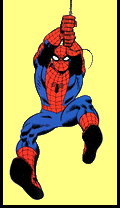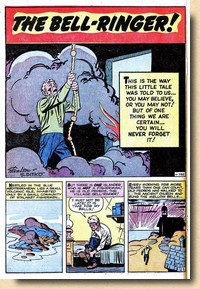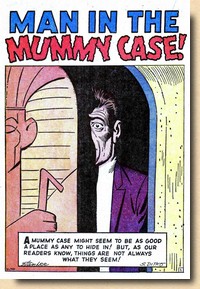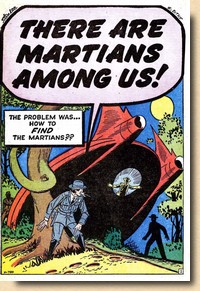|
|
|
|
|
|
BEYOND
AMAZING
THE
MANY REPRINTS OF SPIDER-MAN'S ORIGIN STORY
FROM
AMAZING FANTASY
#15
|
|
|
|
"Spider-Man was
the first Marvel character that lacked an
easy-to-peg connection to the Goodman monster
comics."
(Raphael & Spurgeon,
2003)
"In those days it
took about two or three months to get the
final sales figures of any publication. When
those sales reports [for Amazing Fantasy #15]
finally came in, they showed that the
Spider-Man issue had been a smash success,
perhaps the best-selling comic book of the
whole decade."
(Stan Lee, in Lee &
Mair, 2002)
|
|
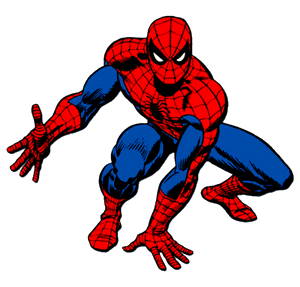
|
|
|
|
|
When
the first issue of a new comic book titled Fantastic Four hit the
news-stands on
August
8th 1961, the success with readers -
triggering no less than the "big bang" of the
Marvel Universe - happened, to a certain degree, by way
of design. Stan
Lee was increasingly at odds with his publisher (and
uncle) Martin Goodman regarding the depth (or Goodman
being okay with a lack thereof) of plots and characters,
and essentially wrote
Fantastic
Four #1 his way and not Goodman's way (McLauchlin,
2018).
|
|
|
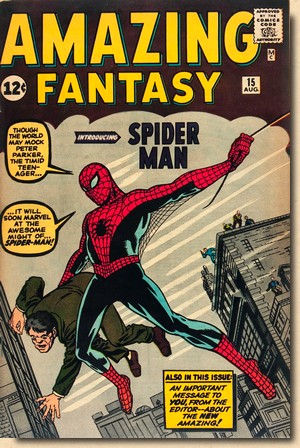
Amazing
Fantasy #15
(August 1962)
|
|
Whether or
not the popular legend that Goodman picked up the
idea that a comic book featuring a group of
superheroes would sell well during a game of golf
with DC publisher Jack Liebowitz is fact or
fiction (Thomas, 2019) actually doesn't matter
that much. Goodman's reputation for sniffing out
material that would sell is just as legendary as
it was real (Hilgart 2014, McLauchlin 2018).
"Martin [Goodman]
was one of the great imitators of all time
(...) Whatever other people were selling, we
would do the same thing (...) Martin was good
at what he did and made a lot of money, but
he wasn't ambitious." (Stan Lee in
Minton, 2009)
Goodman didn't need a game of
golf with Liebowitz to see and understand that
superheroes had just started to click again - he
could see it for himself, with DC's recent
revival of the Flash and their success with the
Justice League. Goodman knew about it, and he
wanted in.
It was therefore an already
proven formula that he told Stan Lee to apply.
What he couldn't know was that Lee and Jack Kirby
would give it their own spin and make it an even
greater hit with readers. But it was still
"success by design".
When Amazing Fantasy #15 went on sale
June 5th 1962
(with a cover date of August and a publication
date of September in the indicia), things were
very different concerning the first appearance of
a character named Spider Man.

|
|
|
|
In
many ways, Stan Lee acted very much like Martin Goodman -
but he was driven by a steadily increasing enthusiasm for
the material and the readers that his uncle lacked
completely.
"[Stan Lee] was always a man on a
mission: constantly working on new ideas. It was as
if he couldn’t stop (...) It’s well known that
what he did was to him just a job at the beginning
(..) He’d write Westerns when Westerns were in,
Horror when that was popular and so forth. It was a
business, and he needed to continually make new
products that would sell." (McLaughlin,
2018)
|
|
|
|
However,
not everything Marvel launched in 1961 turned out
to be a good seller, let alone a smash hit. Amazing
Adventures #1, launched with a cover date of
June 1961, was a monthly title derived straight
from the mould of the long-running Stan Lee and
Jack Kirby sci-fi monster titles, featuring the
same fare published in Strange Tales or Tales
to Astonish with creatures carrying names
such as Torr, Manoo, Monsteroso, or Sserpo.
In one aspect, though, Amazing Adventures
was somewhat different to the other four
Lee/Kirby monster titles - it had a recurring
backup feature with alien-hunting Doctor Droom
(later renamed Doctor Druid to avoid confusion
with Doctor Doom).
It didn't work. Stan Lee renamed the monthly
book Amazing Adult Fantasy as of issue
#7, added the cover tag-line "The magazine
that respects your intelligence", and
brought Steve Ditko on board for the artwork.
|
|
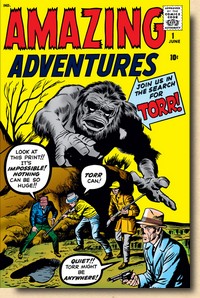
Amazing
Adventures #1
(June 1961)
|
|
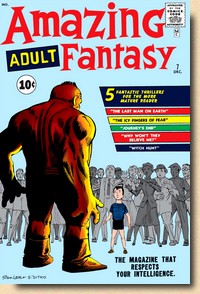
Amazing
Adult Fantasy #7
(December 1961)
|
|
|
|
Every
issue featured five short stories that typically ended on
a twist, the entire concept being an attempt to attract
an older readership. Readers of the title seemed
enthusiastic about the changes, but there still just
weren't enough copies sold (Lee & Mair, 2022). The
days of the sci-fi monster titles were drawing to an end,
eclipsed by the new superhero material on the
news-stands.
"I decided to throw in the towel. I would
do one last issue and then let the book rest in
peace." (Stan Lee in Lee & Mair, 2002)
It is worth noting that several researchers perceive
this to be more of a ret-con myth than an actual fact,
and there are indeed a few compelling indications that
issue #15 was not necessarily planned as the last of the
title (Brevoort, 2019).
|
|
|
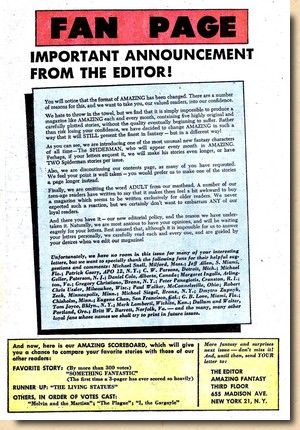
Amazing
Fantasy #15
(August 1962)
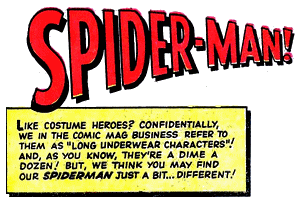
|
|
The
"Fan Page" featured in Amazing
Fantasy #15 was quite unlike the usual
regular letters page. It ran an "important
announcement from the editor" (as promised
on the cover), and while this didn't actually
hint at the end of the title, it did, however,
signal significant changes. In essence, Lee told readers in
his trademark style ("we want to take
you, our valued reader, into our confidence")
that the title's formula featuring five short
stories wasn't sustainable. Apart from dropping
"Adult" from the title ("a
number of our teen-age readers have written to
say that it makes them feel a bit awkward to buy
a magazine which seems to be written exclusively
for older readers"), Lee informed readers that both
structure and content were about to undergo
substantial changes.
"We have
decided to change AMAZING in such a way that
it will STILL present the finest in fantasy -
but in a different way! As you can see, we
are introducing one of the most unusual new
fantasy characters of all time - The
SPIDERMAN., who will appear every month in
AMAZING. Perhaps, if your
letters request it, we will make his stories
even longer, or have TWO Spiderman stories
per issue."
As with any of Marvel's characters of the
1960's, the question of who came up with what and
when, and should therefore be credited with
creating a certain character, is shrouded in
substantial dispute, and Spider-Man is no
exception.
Stan Lee himself credits the inspirational
spark to
"toying with the notion of a new
superhero, one who would be more realistic
than most, despite his colorful superpower.
So I did what I always did in those days, I
took the idea to (...) Martin Goodman. (...)
I also mentioned that our hero, whom I wanted
to call Spider-Man, would be a teenager, with
all the problems, hang-ups, and angst of any
teenager. (...) Except for his super-power,
he'd be the quintessential hard-luck
kid." (Stan Lee in Lee & Mair,
2002)
According to Lee, Goodman downright hated the
idea, since it violated pretty much every rule in
the book on established superhero principles. To
a seasoned publisher like Goodman, this was a
recipe for disaster at the news-stands - the
absolute opposite of what had driven the creation
of the Fantastic Four.
But right at that same time Stan Lee was
prepping the final issue of Amazing Fantasy,
and he sensed an opportunity.
|
|
"Despite the less than exuberant reaction
[from Goodman], I couldn't get Spider-Man out of my
mind. That's when I remembered the final issue of
Amazing Fantasy (...) As you can imagine, when a
publisher prints the last issue of a title, knowing
the book is about to be discontinued, no one much
cares about what goes on in the last issue." (Stan
Lee in Lee & Mair, 2002)
According to Lee, he turned to his go-to superhero
artist, Jack Kirby, with the idea. But after a few pages
he found that Kirby made Peter Parker look way too strong
and confident. It wasn't what Lee had in mind, so he
handed the assignment to Steve Ditko, whose more
toned-down style of drawing matched Lee's ideas
perfectly.
|
|
|
| In the early 1980s, Jack
Kirby would publicly claim Spider-Man to
be his creation (Howe, 2012). Steve Ditko
replied extensively to that statement in
an essay (Ditko, 1990) and pointed out
that any input that Kirby initially had
was discarded and never used. According
to Ditko (who was never really known for
making self-flattering statements) he
discarded Kirby's designs and artwork and
did all the visuals (most importantly
including the costume) from scratch.
As
always, these questions tend to boil down
to what and who people want to believe;
it's also a great play area for lawyers.
Something that would seem undeniable
though is the fact that the Spider-Man of
Amazing Fantasy #15 was the
first Marvel character with no connection
whatsoever to the Kirby/Lee sci-fi
monster formula. While the Fantastic Four
travelled to space and got their
superpowers thanks to cosmic rays,
Ant-Man was an "incredible shrinking
scientist", Hulk begged the question
of whether he was man or monster, and
Thor (whose debut in Journey Into
Mystery #83 hit the news-stands the
very same day that Amazing Fantasy
#15 did) was a god of sorts, Spider-Man
was just a teenage kid from New York City
who never signed up to save the world.
The character was unique, broke new
ground, and proved a perfect vehicle for
Lee's quippy and tongue in cheek style of
telling a story about a regular kid
turning into a "long underwear
character".
|
|
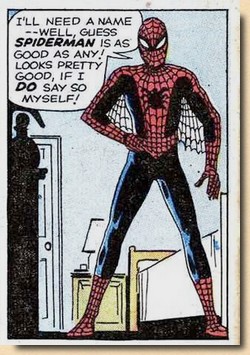
Amazing
Fantasy #15,
panel 5 on page 6 of Spiderman story
|
|
|
|
|
| Also
undisputed is the character's trailblazing success. Amazing
Fantasy did get cancelled after issue 15, but once
the sales figures came in two or three months after
publication, along with letters from readers in praise of
Spider-Man, Lee and Goodman realized that Marvel had a
winner on their hands |
|
|
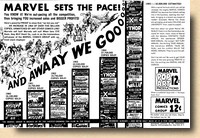
1965 Marvel sales
advertising
|
|
On December 12th
1962, Amazing Spider-Man
#1 hit the news-stands, cover
dated for March 1963. The story
featured the Fantastic Four,
establishing Marvel's policy of
guest appearances that readers
would come to love so much. It is
impossible to contrast the sales
figures for Fantastic Four
and Amazing Spider-Man
during the 1962-1965 period as
Marvel didn't publish said
numbers until 1966.
In that year, Amazing
Spider-Man sold 340,000
copies on average every month,
compared to 329,000 for Fantastic
Four. No publication from
Marvel made it into the 1966 top
ten selling titles, which saw Batman
top out with an average of
898,000 copies sold monthly.
|
|
|
|
|
|
| But
ol' webhead, as Lee would soon start to call him, was
unstoppable, and by 1969 Amazing Spider-Man was
the first Marvel title to ever make it into the annual
top ten sales list. Iin the early 1970s it even surpassed
Superman to become the top-seller in the
industry. |
|
|
|
|
|
| Reprints
of Spider-Man's origin story therefore somewhat logically
often focus on those 11 history making pages of friendly
neighbourhood Spider-Man alone. |
|
|
|
|
      
|
|
|
|
|
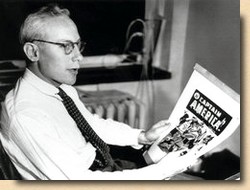
Martin Goodman
(1908-1992)
|
|
Martin
Goodman could look back on a wealth of
business experience, and even though some of his
practices had
gotten him into a spot of trouble with the
Federal Trade Commission in the 1940s (Vassallo,
2014), he had a
keen (some would say shrewd) sense for the gains
to be made from reprints.
"[Goodman]
understood intellectual property only in the
narrowest of business senses: He paid writers
and artists once for their work, and then the
content was his to print or reprint." (Hilgart,
2014)
The success of Marvel's line of
new and different superheroes was staggering, and
it quickly dawned on Goodman that he was looking
at a wonderful
profit
margin if he could sell the same material a
second time - and so Marvel published the 72-page
anthology Marvel Tales Annual #1 on June 11th 1964 .
|
|
|
|
| Hailed as a "collector's
item" on its cover, it featured the first reprint of
Spider-Man's first appearance in Amazing Fantasy
#15 (a mere two years after its original publication),
alongside the origin stories of the Hulk, Ant-Man,
Giant-Man, Sgt. Fury, Iron Man and Thor (all originally
published in 1962 or 1963). |
|
|
|
Marvel
Tales Annual #1
kicked off what would subsequently become
Marvel's output of newly created titles for the
sole purpose of reprinting previously published
material. Originally
conceived as oversize annuals, they would turn
into regular (bi-)monthly titles over time.
However, the word reprint
would be diligently avoided for most of the time
at this stage - the splash page reproduced in Marvel Tales Annual
#1 instead stating "EXACTLY AS IT
APPEARED IN AMAZING FANTASY #15".
|
|
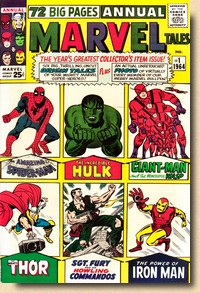
Marvel
Tales Annual #1
(June 1964)
|
|
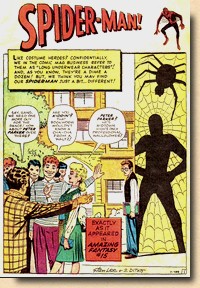
Marvel
Tales Annual #1
(June 1964)
|
|
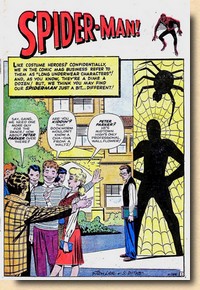
Amazing
Fantasy #15
(August 1962)
|
|
|
|
| Which actually wasn't quite
true, as some minor recolouring had taken place. But
other than that, readers did get a complete and unaltered
reprint of Spider-Man's origin story from Amazing
Fantasy #15. Since Marvel was at that point
in time starting to turn out more and more material
featuring its new and successful superheroes, there was
no need to revisit what had already been reprinted once.
It would subsequently be a fairly long wait for readers
in the States until they would see Spidey's first
appearance from
Amazing
Fantasy #15 again.
But the growing success
of Marvel's superheroes resulted in that material
appearing outside of the United States. It would seem
appropriate to call this a process of re-publishing
rather than re-printing, and the very first such
publication of Marvel's new superhero material outside
the US (and also in a language other than English at the
same time) took place with almost no delay at all when
publisher La Prensa put out Spanish versions of Los 4
Fantásticos #1 in September 1962 and El
Sorprendente Hombre Araña #1 in June 1963 for
readers in Mexico.
The latter title has attracted quite a bit of
attention these past few years for the fact that La
Prensa published stories and artwork created by Mexican
artists in issues #122-185 that were completely outside
the US continuity and thus featured something of a
parallel Spider-Man universe.
|
|
|
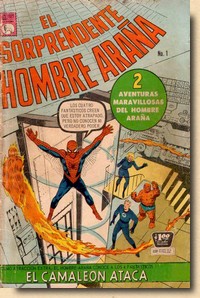
El Sorprendente
Hombre Araña #1
(Mexico, La Prensa, June 1963)
|
|
However,
the all-colour Sorprendente
Hombre Araña #1 kicked off
Spidey's adventures for Mexican
readers (as the cover rightly
suggests) with a reprint of Amazing
Spider-Man #1, and his
actual origin story from Amazing
Fantasy #15 would not be
published in Mexico until April
1980, when publisher Novidades
Editores put out El Asombroso
Hombre Araña #1.
The
first republication of
Spider-Man's true first
appearance - his origin story
from Amazing Fantasy
#15 - took place in the UK, in
the black and white pages of Out
Of This World #17.
Published by Alan Class Comics (who
made use of US material in random
order and with no regard to
continuity), this is believed to
have happened around October
1964. But since no Alan
Class comic book every carried a
date on the cover (and very often
not even on any inside pages),
things are a bit foggy.
Class lost the rights to
publish Marvel characters in 1966
to Odhams Press, who relaunched
Spider-Man in Pow! #1 in
January 1967. However, they - as
La Prensa before them - chose to
start out with the material from
Amazing Spider-Man #1
and ignored his actual origin
from Amazing Fantasy
#15.
|
|
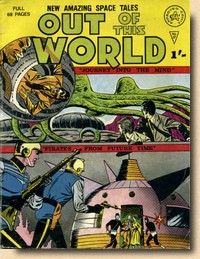
Out Of This World #17
(UK, Alan Class, October 1964)
|
|
|
|
|
|
|
Odham's
presentation of Marvel material from 1966 to 1968 had
always been slightly odd. Whilst editorial copied the
style of Stan Lee's banter heavily, the word
"Marvel" was never spoken. Instead, they
referred to themselves as "Power-House"
and told readers about the "progress of
Powerdom" (ironically, Odham ceased its
publication business by the end of 1968). Spider-Man's
first appearance remained out of publication between 1964
and 1970, until Italian publisher Editoriale Corno put
out Italy's first continuous comic book series featuring
Marvel superhero material: L'Uomo Ragno
(Brambilla, 2020). The publisher from Milan would however
have none of the chaotic editorial policies displayed by
Class and Odham in the UK, and set out on publishing
Spider-Man's adventures in strict chronological order of
their original publication.
This meant that, almost hiding behind a somewhat
generic John Romita cover (produced by reworking a panel
from Amazing Spider-Man #48), L'Uomo Ragno
#1 introduced Italian readers to Spidey through his true
origin story from Amazing Fantasy #15 (followed
by his adventure from Amazing Spider-Man #1 and
the Sorcerer Supreme's revamped origin story from Doctor
Strange #169 as a backup for good measure, since
Italian readers were accustomed to comic books with a
higher page count).
|
|
|
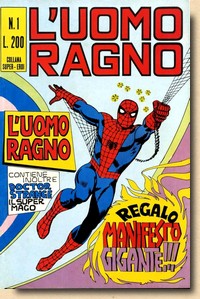
L'Uomo Ragno #1
(Italy, Corno, April 1970)
|
|
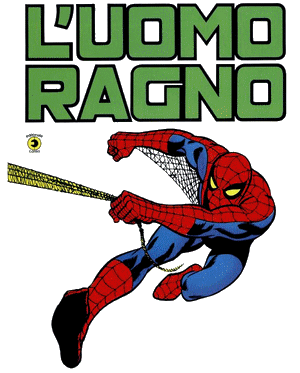
|
|
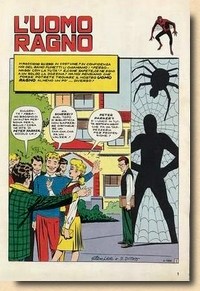
L'Uomo Ragno #1
(Italy, Corno, April 1970)
|
|
|
|
|
|
| It
is interesting, as a side note, to see how foreign
language publishers throughout the 1960s, 1970s and 1980s
would generally translate or transpose the names of
Marvel characters. Spider-Man thus became el Hombre
Araña in Spanish, l'Uomo Ragno in Italian, die Spinne in
German, Spinneman in Dutch, Spindelmannen in Swedish,
Edderkoppen in Norwegian, or even Kóngulóarmaðurinn in
Icelandic. It was mostly only in the wake
of the Spider-Man movies that publishers opted to just
call the character Spider-Man, no matter the language of
publication. |
|
|
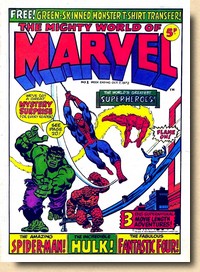
Mighty World Of
Marvel #1
(UK, October 1972)
|
|
No
translation was needed for the
next republishing of ol'
webhead's origin story from Amazing
Fantasy #15 when Mighty
World of Marvel #1 hit the
news-stands in the UK - published
by Marvel's own UK imprint
(commonly known and referred to
as Marvel
UK) in October 1972. It
was the start of a highly
successful venture onto the
British comic book market for
Marvel, and a number of black and
white weekly titles (one of them
being Mighty World of Marvel)
would (re-)introduce a whole
array of Marvel characters - this
time in proper chronological
order.
It was thus only logical that
Spider-Man would start out with
his true first tale, from
Amazing
Fantasy #15
-
although Mighty World of
Marvel #1 dropped page 7
(which introduces "Part
2" of the story) and used a
somewhat odd
"spot-colour" printing
using a green/blue hue.
|
|
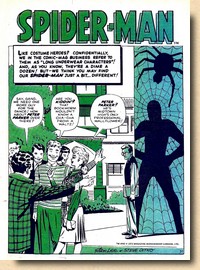
Mighty World Of
Marvel #1
(UK, October 1972)
|
|
|
|
|
|
|
Both
L'Uomo Ragno in 1970 and Mighty World of
Marvel in 1972 signalled a significant change of affairs. When Marvel's superhero material started
to be published outside the US (including non-English
speaking countries) during the 1960s, this was usually
either done in the completely haphazard way of Alan Class
or, if the publishing chronology was somewhat respected,
with later start-off points. The latter approach was
typically the case for Spider-Man, where re-publication
commonly started with Amazing Spider-Man #1 (as
in El Sorprendente Hombre Araña #1),
while the "Alan Class" route was exemplified by
German publisher BSV who decided,
for no apparent reason, to start their Hit-Comics
#1 in 1966 with Amazing Spider-Man #29. But no
matter where publishers decided to start their Spider-Man
series, they would previously not do so with the origin
story from
Amazing
Fantasy #15.
|
|
|
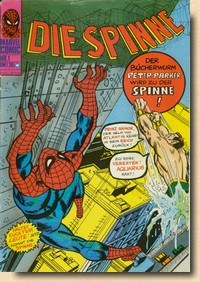
Die Spinne #1
(Germany, Williams, January 1974)
|
|
In January 1974
German publisher Williams Verlag
(one of several publishing houses
in Europe owned by Warner
Brothers at the time) launched a
range of seven titles featuring
Marvel superheroes and horror
material in January 1974.
And just like
Editore Corno in 1970 and Marvel
UK in 1972, Williams followed the
original order of publication in
the US. Die Spinne #1
thus introduced German language
readers to Spider-Man through his
origin as published in
Amazing
Fantasy #15.

Williams decided to go with
the cover of Amazing
Spider-Man #98 because it
could easily be altered to show
Namor (instead of the Green
Goblin), who appeared in Die
Spinne as backup feature.
The same cover, in its original
setup, would be used again for Die
Spinne #99.
|
|
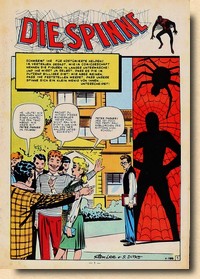
Die Spinne #1
(Germany, Williams, January 1974)
|
|
|
|
|
|
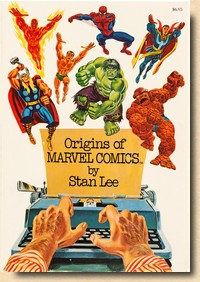
Origins
of MarvelComics
(Simon and Schuster, 1974)
|
|
1974 was also the
year that Spider-Man, along with
a few other Marvel superheroes,
made it into an actual book for
the first time when Simon and
Schuster published Origins of
MarvelComics.
As the title
promised, it contained the origin
stories of the characters
featured along with selected
further adventures, and for
Spider-Man this meant a
re-publishing of his origin from
Amazing
Fantasy #15.
The next chance to read
Spidey's origin occurred in
September 1977, and it too was
served up in a format very
different from the regular single
issue comic books. Marvel's
"pocket books" in yet
another collaboration with Simon
and Schuster featured colour
reprints but re-sized to the
standard paperback book size.
Featured within the 164 pages
of Amazing Spider-Man #1
were the web-crawlers first seven
adventures in chronological
order, including
Amazing
Fantasy #15 (the cover blurb
erroneously only counted the
issues of Amazing Spider-Man).
|
|
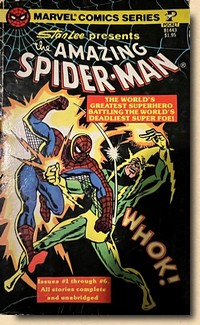
Amazing
Spider-Man #1
(Pocket Books, September 1977)
|
|
|
|
|
|
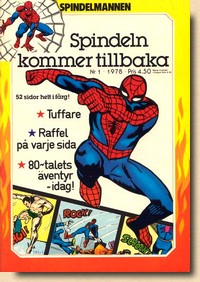
Spindelmannen
#1
(Sweden, Atlantic, January 1978)
|
|
1978 saw another
republishing of Spidey's origin
story in a language other than
English as Atlantic Förlags AB
introduced its Swedish readers to
Peter Parker and Spider-Man in
the 52 colour pages of Spindelmannen
#1.
The very same month, Atlantic
Förlags published the identical
comic book in Norwegian too, as Edderkoppen
#1. Since both were printed
in Finland, this made for a
highly economical way to serve
two different language markets -
a business model Atlantic
Förlags (and its successor
Semic) would employ frequently.
Following German, Swedish and
Norwegian re-publications (of
Spidey's origin from
Amazing
Fantasy #15, not Spider-Man
material in general), 1978 also
saw a more exotic language join
the fold when Kobunsha of Japan
published
スパイダーマン (Supaidaman) #1.
The next
re-publication, from 1979, took
place in more familiar waters
again.
|
|
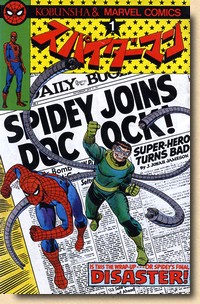
スパイダーマン
#1
(Japan, Kobunsha, 1978)
|
|
|
|
|
|
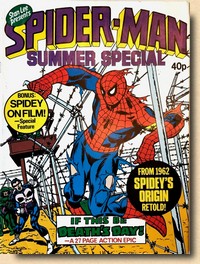
Spider-Man
Summer Special
(UK, Marvel UK, 1979)
|
|
Annuals
were a long-standing tradition of
the British comic book market and
provided publishers with a
welcome boost of sales during the
summer holidays.
Marvel UK
made sure to get a slice of that
cake too by publishing several
annuals, and the 1979 Spider-Man
Summer Special saw
Spider-Man's origin from
Amazing
Fantasy #15 now re-published
for the second time in the UK -
with a special cover blurb to
boot, yet still, however, in
black and white.
Clearly,
with the ever growing reach of
Marvel's superhero material,
there was also an expanding
market for very early (origin)
stories. After only a few
occasional reprints in the 1960s
and early 1970s of Spider-Man's
first published adventure, those
pages from Amazing Fantasy
#15 now started to see a lot more
publication, and in an ever
expanding fold of languages and
countries.
|
|

|
|
|
|
|
|
| In
fact so much so that once you start looking at the 1980s
and beyond, the re-publications of Spider-Man's origin
story from 1962 become almost too numerous to sensibly
list. There were, however, one or two that stand out. |
|
|
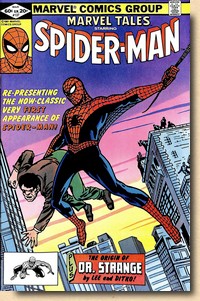
Marvel
Tales #137
(March 1982)
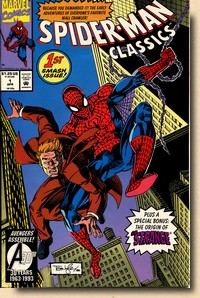
Spider-Man
Classics #1
(April 1993)
|
|
Marvel
Tales #137 (the title could
trace its roots to the 1964
Marvel
Tales Annual #1, the first
comic book ever to reprint
Spider-Man's origin story, and
had been a Spider-Man reprint
title for years) announced on its
cover in March 1982 that it was "re-presenting
the now-classic very first
appearance of Spider-Man".
But readers got more than just
that - on an interior page they
could see, for the first time in
colour,
the cover that
Steve Ditko had originally
pencilled and inked for Amazing
Fantasy #15.
|
It was
featured again, In early
1993, when Marvel decided
to launch Spider-Man
Classics, a title
that would reprint early
Spider-Man material every
month, ultimately running
for a total of issues
between April 1993 and
July 1994. Why Jack
Kirby's cover was chosen
over Steve Ditko's is,
like so many other things
in connection with the
creation of Spider-Man,
the subject of various
differing accounts and,
most likely, outright
legends.
Some point to Martin
Goodman not liking
Ditko's cover (which
doesn't quite rhyme with
Stan Lee's somewhat
substantiated statement
that Goodman couldn't
have cared and thought
less about Spider-Man),
while others attribute
this to the fact that
Kirby was Marvel's go-to
cover artist in 1962 as
the decisive element
(which seems a likely
explanation).
|
|
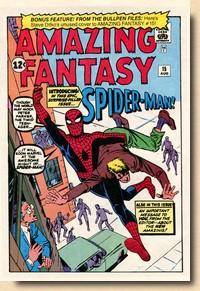
Spider-Man
Classics #1
(April 1993)
|
Ditko's cover
had been known to exist at least
since the late 1960s, when it was
published in a Marvel fanzine
(Brevoort, 2019), but would have
been absolute news for most
readers both of Marvel Tales
#137 in 1982 and Spider-Man
Classics #1 in 1993.
It was used again, but this
time as actual cover, for Amazing
Spider-Man #700 (February
2013) - albeit as one of twelve
variant covers.
Possibly the ultimate
re-publication of Spider-Man's
origin story from 1962 took place
in December 2019, when Marvel
published a facsimile edition of Amazing
Fantasy #15, featuring not
only the Spidey story but also
including the three Lee &
Ditko horror stories plus all the
pages (including advertising) as
originally published.
The only four things (other
than a notice in the indicia)
acting as tell-tale signs that
this wasn't a comic book from
1962 were the quality of the
paper used (glossy, no
newsprint), the cover price ($
3.99), the barcode in the lower
left hand corner of the cover,
and the modern MARVEL logo in the
lower right-hand corner.
|
|
|
|
|
|
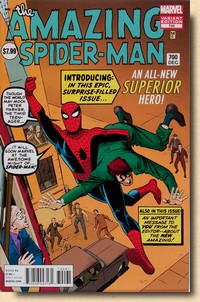
Amazing
Spider-Man #700
(February 2013, Variant Cover)
|
|
Attributing the
title of "most often
re-printed comic book story"
depends on the criteria chosen.
Spider-Man's origin story from Amazing
Fantasy #15 is certainly up
there, since re-publication
really took off since the 1980s. But then the
importance lies more with the
influence on comic book history,
rather than just simple quantity.
And in that respect, Spider-Man
is indeed "beyond
Amazing".

|
|
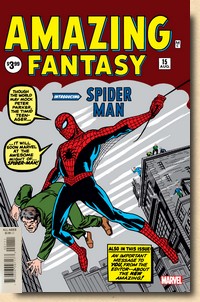
Amazing
Fantasy #15
(Facsimile, December 2019)
|
|
|
|
|
|
|
|
|
BIBLIOGRAPHY
|
|
|
|
|
BRAMBILLA
Alberto (2020) "50
anni fa, il primo fumetto dell’Uomo Ragno in
Italia", FumettoLogica,
published online 30 April 2020 BREVOORT
Tom (2019) "Lee
& Ditko: Amazing Fantasy #15", The
Tom Brevoort Experience, published online 3
March 2019
DITKO Steve (1990) "Jack
Kirby's Spider-Man", Robin Snyder's History of the Comics,
Vol. 1, #5 [the essay is reproduced
here]
HILGART John (2014) "Review
of: The Secret History of Marvel Comics",
The Comics Journal
HOWE Sean (2012) Marvel
Comics: The Untold Story, Harper Collins
LEE Stan
& George MAIR (2002) Excelsior! The
Amazing Life of Stan Lee, Simon &
Schuster
McLAUCHLIN
Jim (2018) "The
Enduring Mysteries of FANTASTIC FOUR #1 (and
their possible Answers)", in Newsarama, published
online 8 August 2018 (accessed by way of
archive.org)
McLAUGHLIN
Jeff (2018) "Guest
Blog: Jeff McLaughlin on Stan Lee", University
Press of Mississippi Blog, published online
28 December 2018
MINTON Jeff (2009) “How
I Did It: Stan Lee of Marvel Comics”, Inc
Magazine, November 2009
RAPHAEL
Jordan & Tom SPURGEON (2003) Stan
Lee and the Rise and Fall of the American Comic
Book, Chicago Review Press
THOMAS
Roy (2019) "Stan's Soapbox
Sidebar", Alter Ego #161,
TwoMorrows
VASSALLO
Michael J. (2014) "Martin
Goodman: The Crime Digest Paperbacks", Timely-Atlas-Comics
Blog, June 2014
|
|
|
|
|
|
|
|
|
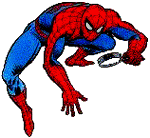

(c) 2022
uploaded
to the web 7 July 2022
|
|
|
|
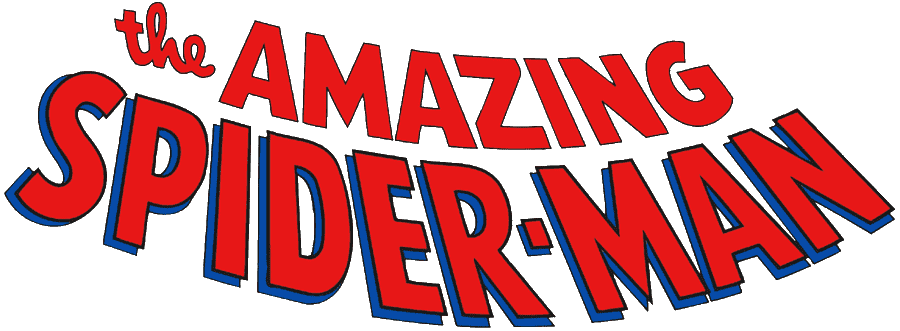 |
|

